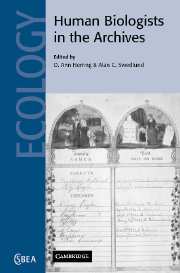 Human Biologists in the Archives
Human Biologists in the Archives Book contents
- Frontmatter
- Contents
- Contributors
- Foreword by Sydel Silverman and Michael A. Little
- Acknowledgements
- 1 Human biologists in the archives: demography, health, nutrition and genetics in historical populations
- 2 The use of archives in the study of microevolution: changing demography and epidemiology in Escazú, Costa Rica
- 3 Anthropometric data and population history
- 4 For everything there is a season: Chumash Indian births, marriages, and deaths at the Alta California missions
- 5 Children of the poor: infant mortality in the Erie County Almshouse during the mid nineteenth century
- 6 Worked to the bone: the biomechanical consequences of ‘labor therapy’ at a nineteenth century asylum
- 7 Monitored growth: anthropometrics and health history records at a private New England middle school, 1935–1960
- 8 Scarlet fever epidemics of the nineteenth century: a case of evolved pathogenic virulence?
- 9 The ecology of a health crisis: Gibraltar and the 1865 cholera epidemic
- 10 War and population composition in Åland, Finland
- 11 Infectious diseases in the historical archives: a modeling approach
- 12 Where were the women?
- 13 Malnutrition among northern peoples of Canada in the 1940s: an ecological and economic disaster
- 14 Archival research in physical anthropology
- Index
- References
14 - Archival research in physical anthropology
Published online by Cambridge University Press: 12 August 2009
- Frontmatter
- Contents
- Contributors
- Foreword by Sydel Silverman and Michael A. Little
- Acknowledgements
- 1 Human biologists in the archives: demography, health, nutrition and genetics in historical populations
- 2 The use of archives in the study of microevolution: changing demography and epidemiology in Escazú, Costa Rica
- 3 Anthropometric data and population history
- 4 For everything there is a season: Chumash Indian births, marriages, and deaths at the Alta California missions
- 5 Children of the poor: infant mortality in the Erie County Almshouse during the mid nineteenth century
- 6 Worked to the bone: the biomechanical consequences of ‘labor therapy’ at a nineteenth century asylum
- 7 Monitored growth: anthropometrics and health history records at a private New England middle school, 1935–1960
- 8 Scarlet fever epidemics of the nineteenth century: a case of evolved pathogenic virulence?
- 9 The ecology of a health crisis: Gibraltar and the 1865 cholera epidemic
- 10 War and population composition in Åland, Finland
- 11 Infectious diseases in the historical archives: a modeling approach
- 12 Where were the women?
- 13 Malnutrition among northern peoples of Canada in the 1940s: an ecological and economic disaster
- 14 Archival research in physical anthropology
- Index
- References
Summary
Introduction
My aim is to present an overview of the main trends in the development and practice of archival anthropology, reflecting on the paths by which the project has developed, and noting not only the mainstream, but also the occasional intriguing backwater. Before moving on in later sections to a description of data sources, analytical approaches, and exemplary studies, I shall briefly outline the broad range of anthropological studies that utilize archival data, and offer some thoughts on the particular qualities of the sources which lend themselves to anthropological analysis. Finally, I give some hostages to fortune in a brief statement of future directions for this endeavor. Now and then, I shall indicate a little of the parallel work done especially by historians and historical geographers, to remind us of the commonality of interest across academic disciplines, and to show what keeps the biological anthropology distinct.
Archival anthropology is in many ways no different in spirit and intent from the discipline as followed by many workers studying living populations. Often the investigators are the same people and the only difference is the provenance of the data. That said, the fact of relying on archival data imposes its own special constraints, grants its own freedoms, and inculcates a community of interest among practitioners across disciplines – the anthropologist and the historian in the record office can sometimes feel equally remote from their colleagues in the disciplines' mainstream.
- Type
- Chapter
- Information
- Human Biologists in the ArchivesDemography, Health, Nutrition and Genetics in Historical Populations, pp. 311 - 336Publisher: Cambridge University PressPrint publication year: 2002


